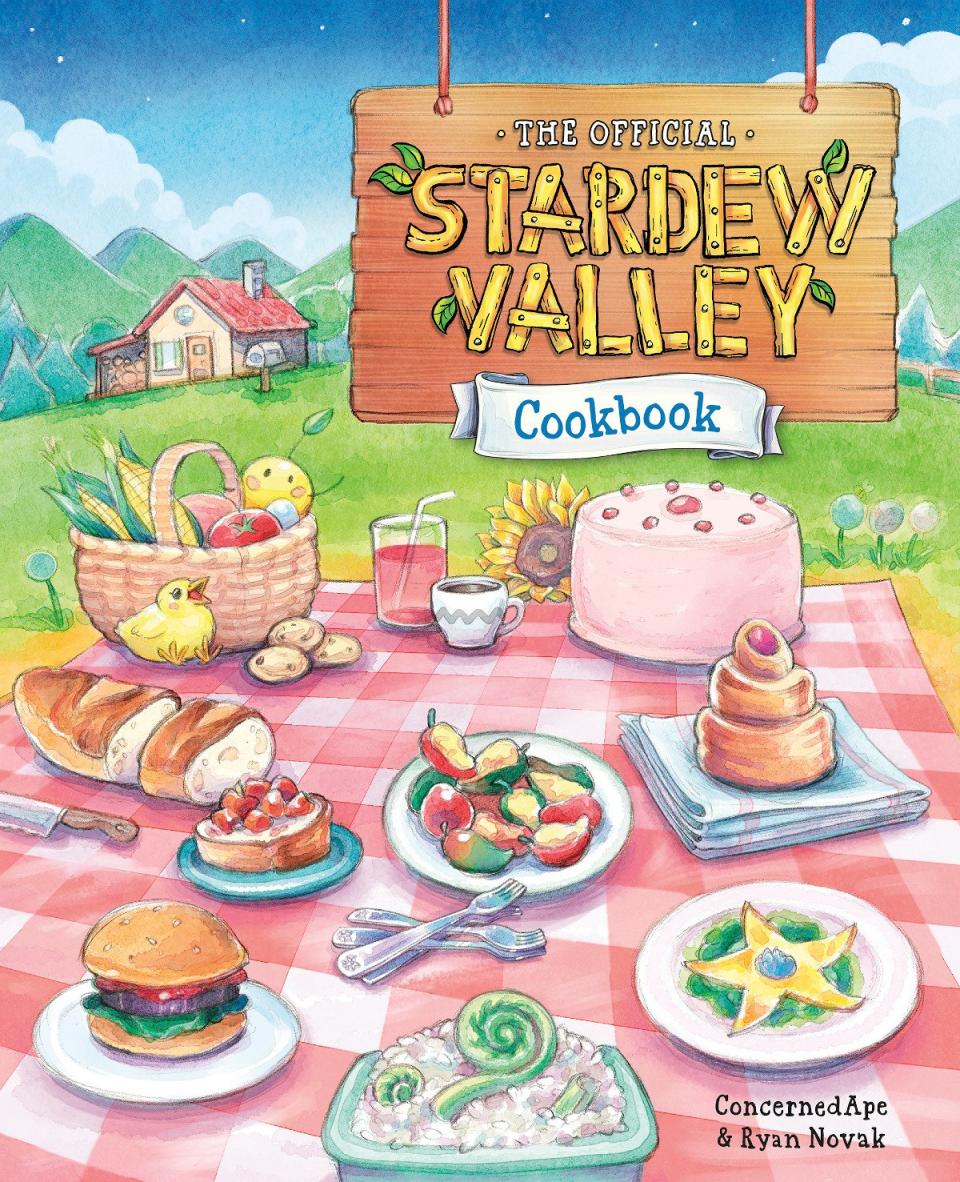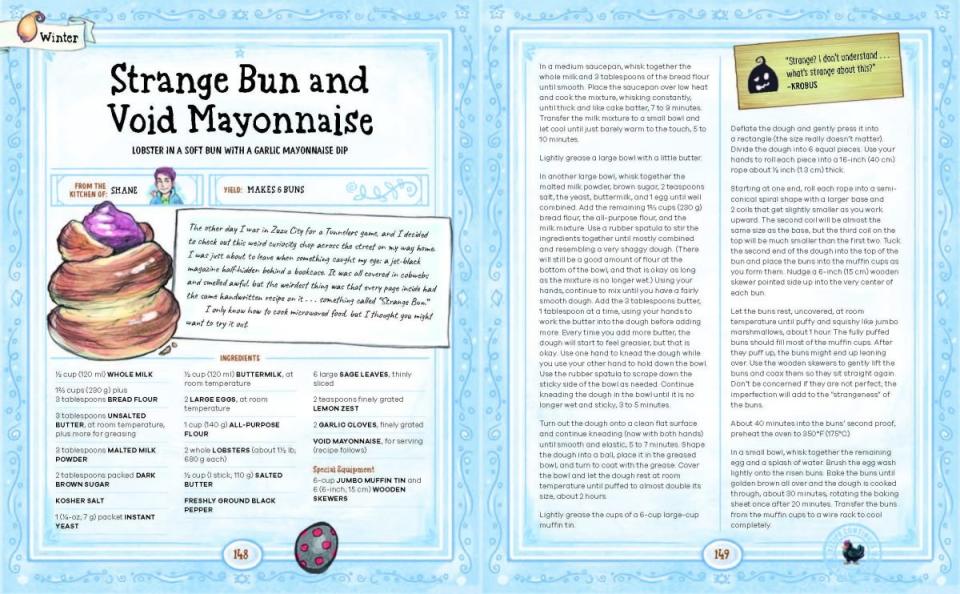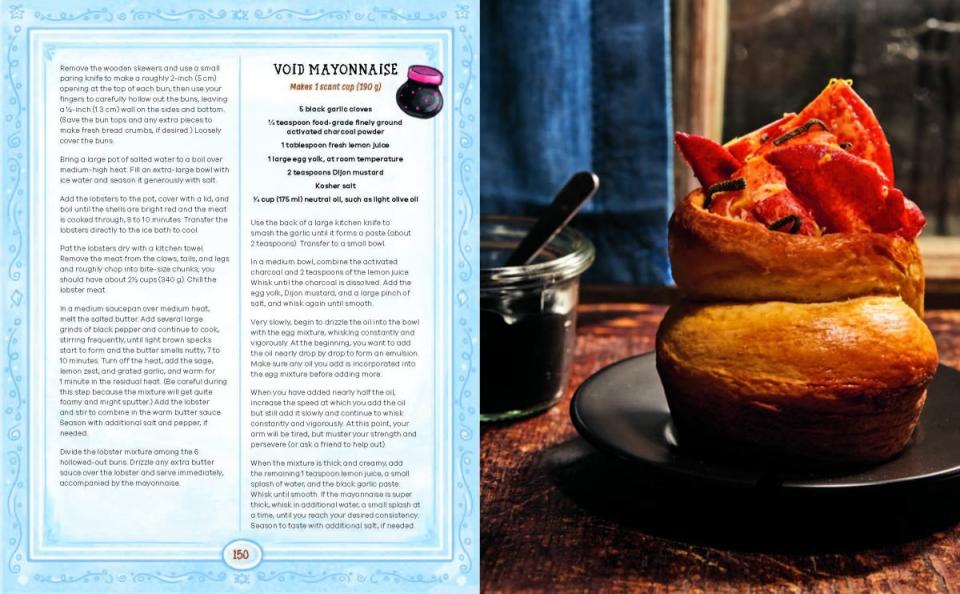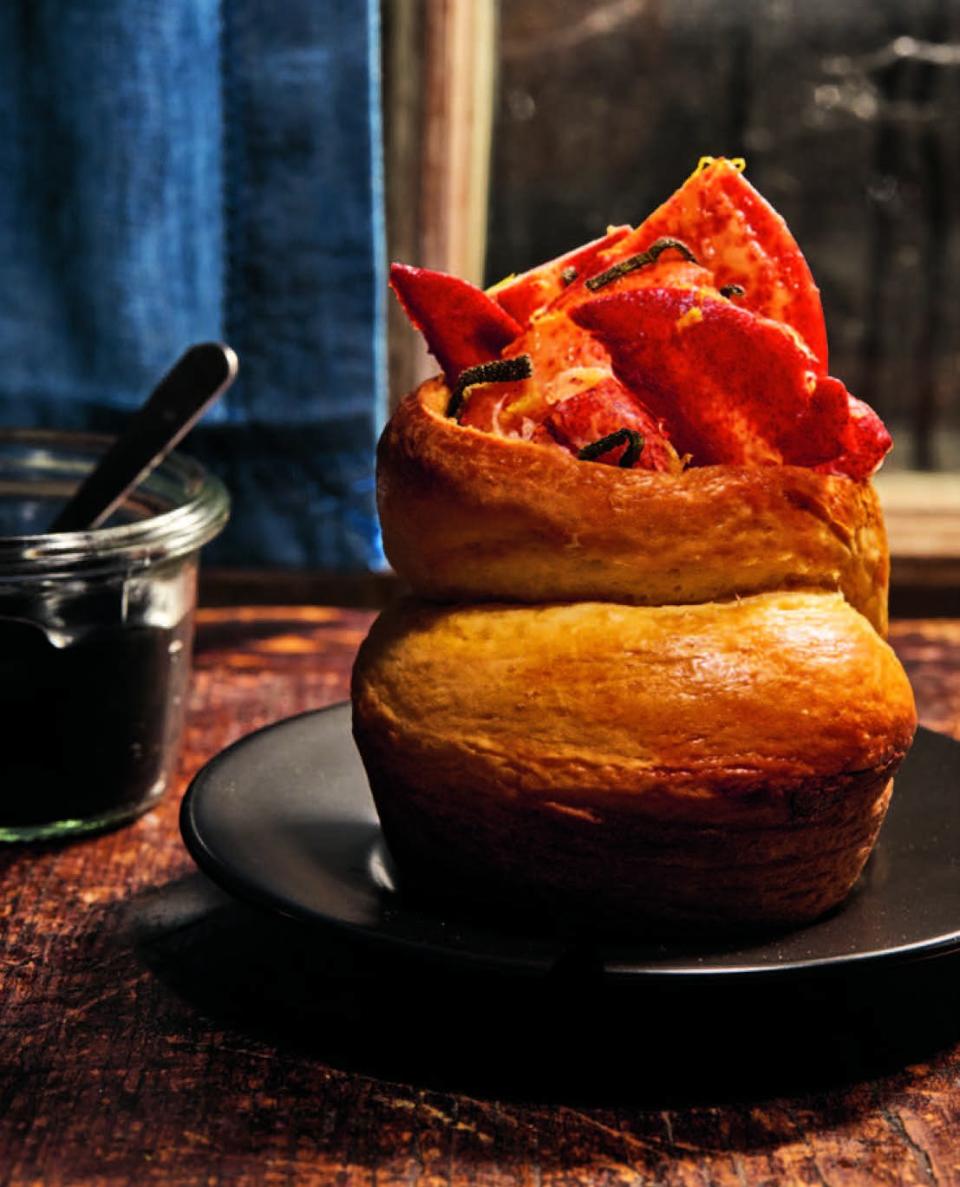Learn How to Make STARDEW VALLEY’s Strange Bun and Void Mayonnaise
If you’ve played Stardew Valley, you know how big an element food plays in the game. You grow it on your farm, you forage for it, you fish for it. Then you craft meals and use them to win the hearts of your fellow Pelican Town villagers. Or maybe you keep those meals for yourselves to provide plenty of energy for long expeditions in the mines. Whatever your motivation for learning recipes in the game, you don’t need any reason to prepare them in real life besides the fact that you want to. The Official Stardew Valley Cookbook by game creator Eric “ConcernedApe” Barone and Ryan Novak gives you all the reasons you need to pretend to be The Queen of Sauce. You can get started now because we have your exclusive look at recipes for the Strange Bun and Void Mayonnaise.

The Stardew Valley cookbook follows the seasonal vibes of the popular video game. Recipes are divided by the time of year and taken from the in-game meals and food. This cookbook is more than only recipes, though. You get photographs, original illustrations, and lots of little character notes. For this Stardew Valley enthusiast who has put hundreds of hours into different farms, it’s delightful.
You can get a taste of the illustrations and photographs in The Official Stardew Valley Cookbook in these Strange Bun and Void Mayonnaise recipe pages. We know almost no characters like these items in the game, but out of the game? Both recipes sound delicious.
Click To View Gallery



And here are the recipes:
Strange Bun and Void Mayonnaise
LOBSTER IN A SOFT BUN WITH A GARLIC MAYONNAISE DIP
From the Kitchen of: Shane
Yield: Makes 6 Buns
INGREDIENTS:
1/2 cup (120 ml) WHOLE MILK
1 2/3 cups (230 g) plus 3 tablespoons BREAD FLOUR
3 tablespoons UNSALTED BUTTER, at room temperature, plus more for greasing
3 tablespoons MALTED MILK POWDER
2 tablespoons packed DARK BROWN SUGAR
KOSHER SALT
1 (1/4-oz; 7 g) packet INSTANT YEAST
1/2 cup (120 ml) BUTTERMILK, at room temperature
2 LARGE EGGS, at room temperature
1 cup (140 g) ALL-PURPOSE FLOUR
2 whole LOBSTERS (about 1 1/2 lb; 680 g each)
1/2 cup (l stick; 110 g) SALTED BUTTER
FRESHLY GROUND BLACK PEPPER
6 large SAGE LEAVES, thinly sliced
2 teaspoons finely grated LEMON ZEST
2 GARLIC CLOVES, finely grated
VOID MAYONNAISE, for serving (recipe follows)
Special Equipment:
6-cup JUMBO MUFFIN TIN and 6 (6-inch; 15 cm) WOODEN SKEWERS
In a medium saucepan, whisk together the whole milk and 3 tablespoons of the bread flour until smooth. Place the saucepan over low heat and cook the mixture, whisking constantly, until thick and like cake batter, 7 to 9 minutes. Transfer the milk mixture to a small bowl and let cool until just barely warm to the touch, 5 to 10 minutes.
Lightly grease a large bowl with a little butter.
In another large bowl, whisk together the malted milk powder, brown sugar, 2 teaspoons salt, the yeast, buttermilk, and 1 egg until well combined. Add the remaining 1 2/3 cups (230 g) bread flour, the all-purpose flour, and the milk mixture. Use a rubber spatula to stir the ingredients together until mostly combined and resembling a very shaggy dough. (There will still be a good amount of flour at the bottom of the bowl, and that is okay as long as the mixture is no longer wet.) Using your hands, continue to mix until you have a fairly smooth dough. Add the 3 tablespoons butter, 1 tablespoon at a time, using your hands to work the butter into the dough before adding more. Every time you add more butter, the dough will start to feel greasier, but that is okay. Use one hand to knead the dough while you use your other hand to hold down the bowl. Use the rubber spatula to scrape down the sticky side of the bowl as needed. Continue kneading the dough in the bowl until it is no longer wet and sticky, 3 to 5 minutes.
Turn out the dough onto a clean flat surface and continue kneading (now with both hands) until smooth and elastic, 5 to 7 minutes. Shape the dough into a ball, place it in the greased bowl, and turn to coat with the grease. Cover the bowl and let the dough rest at room temperature until puffed to almost double its size, about 2 hours.
Lightly grease the cups of a 6-cup large-cup muffin tin.
Deflate the dough and gently press it into a rectangle (the size really doesn’t matter). Divide the dough into 6 equal pieces. Use your hands to roll each piece into a 16-inch (40 cm) rope about 1/2 inch (1.3 cm) thick.
Starting at one end, roll each rope into a semi-conical spiral shape with a larger base and 2 coils that get slightly smaller as you work upward. The second coil will be almost the same size as the base, but the third coil on the top will be much smaller than the first two. Tuck the second end of the dough into the top of the bun and place the buns into the muffin cups as you form them. Nudge a 6-inch (15 cm) wooden skewer pointed side up into the very center of each bun.
Let the buns rest, uncovered, at room temperature until puffy and squishy like jumbo marshmallows, about 1 hour. The fully puffed buns should fill most of the muffin cups. After they puff up, the buns might end up leaning over. Use the wooden skewers to gently lift the buns and coax them so they sit straight again. Don’t be concerned if they are not perfect; the imperfection will add to the “strangeness” of the buns.
About 40 minutes into the buns’ second proof, preheat the oven to 350°F (175°C).
In a small bowl, whisk together the remaining egg and a splash of water. Brush the egg wash lightly onto the risen buns. Bake the buns until golden brown all over and the dough is cooked through, about 30 minutes, rotating the baking sheet once after 20 minutes. Transfer the buns from the muffin cups to a wire rack to cool completely.
Remove the wooden skewers and use a small paring knife to make a roughly 2-inch (5 cm) opening at the top of each bun, then use your fingers to carefully hollow out the buns, leaving a 1/2-inch (1.3 cm) wall on the sides and bottom. (Save the bun tops and any extra pieces to make fresh bread crumbs, if desired.) Loosely cover the buns.
Bring a large pot of salted water to a boil over medium-high heat. Fill an extra-large bowl with ice water and season it generously with salt.
Add the lobsters to the pot, cover with a lid, and boil until the shells are bright red and the meat is cooked through, 8 to 10 minutes. Transfer the lobsters directly to the ice bath to cool.
Pat the lobsters dry with a kitchen towel. Remove the meat from the claws, tails, and legs and roughly chop into bite-size chunks; you should have about 2 1/2 cups (340 g). Chill the lobster meat.
In a medium saucepan over medium heat, melt the salted butter. Add several large grinds of black pepper and continue to cook, stirring frequently, until light brown specks start to form and the butter smells nutty, 7 to 10 minutes. Turn off the heat, add the sage, lemon zest, and grated garlic, and warm for 1 minute in the residual heat. (Be careful during this step because the mixture will get quite foamy and might sputter.) Add the lobster and stir to combine in the warm butter sauce. Season with additional salt and pepper, if needed.
Divide the lobster mixture among the 6 hollowed-out buns. Drizzle any extra butter sauce over the lobster and serve immediately, accompanied by the mayonnaise.
VOID MAYONNAISE
Makes 1 scant cup (190 g)
5 black garlic cloves
1/4 teaspoon food-grade finely ground activated charcoal powder
1 tablespoon fresh lemon juice
1 large egg yolk, at room temperature
2 teaspoons Dijon mustard
Kosher salt
3/4 cup (175 ml) neutral oil, such as light olive oil
Use the back of a large kitchen knife to smash the garlic until it forms a paste (about 2 teaspoons). Transfer to a small bowl.
In a medium bowl, combine the activated charcoal and 2 teaspoons of the lemon juice. Whisk until the charcoal is dissolved. Add the egg yolk, Dijon mustard, and a large pinch of salt, and whisk again until smooth.
Very slowly, begin to drizzle the oil into the bowl with the egg mixture, whisking constantly and vigorously. At the beginning, you want to add the oil nearly drop by drop to form an emulsion. Make sure any oil you add is incorporated into the egg mixture before adding more.
When you have added nearly half the oil, increase the speed at which you add the oil but still add it slowly and continue to whisk constantly and vigorously. At this point, your arm will be tired, but muster your strength and persevere (or ask a friend to help out).
When the mixture is thick and creamy, add the remaining 1 teaspoon lemon juice, a small splash of water, and the black garlic paste. Whisk until smooth. If the mayonnaise is super thick, whisk in additional water, a small splash at a time, until you reach your desired consistency. Season to taste with additional salt, if needed.
Reprinted from The Official Stardew Valley Cookbook by ConcernedApe and Ryan Novak. © 2024 by ConcernedApe LLC. Published by Random House Worlds, an imprint of Random House, a division of Penguin Random House LLC.
The Official Stardew Valley Cookbook arrives on May 14. You can place a pre-order now.

